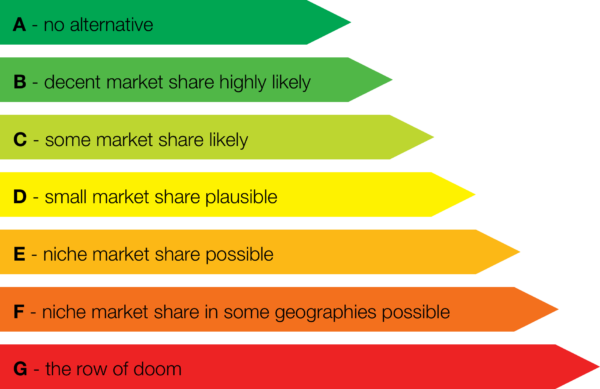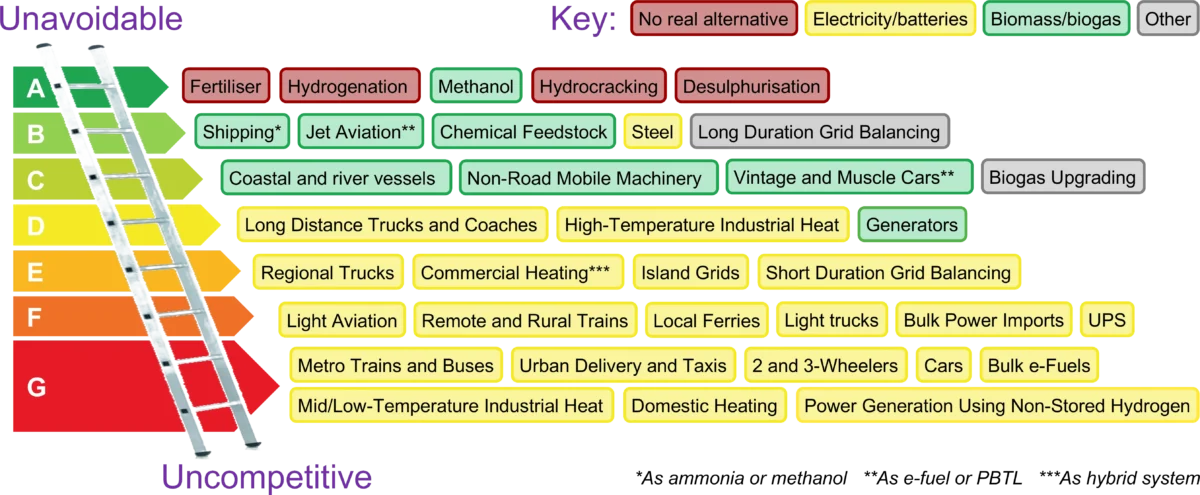Sign up for our newsletter!
Your data will be handled in compliance with our privacy policy.
Your data will be handled in compliance with our privacy policy.

Clean hydrogen is essential to limit global warming to below 2°C. Despite the influx of funding, widespread adoption is difficult due to the limited availability of green electricity. Michael Liebreich suggests prioritizing applications via his Hydrogen Ladder framework. In this blog post we explore its implications.
Clean hydrogen is seen by most people familiar with the subject, from experts to politicians, as a crucial tool to stop global warming before it exceeds 2 °C. That’s why governments and investors are throwing money at almost any project that uses clean hydrogen. This is tempting many to try to strike gold with clean hydrogen projects; initiatives, projects and large-scale plants are springing up like mushrooms in a wide range of applications.
But, says Michael Liebreich, a prominent figure in the clean hydrogen discourse, there will not be enough green energy to produce clean hydrogen for all applications.
He therefore wants to steer stakeholders away from fuel cell cars and other applications where batteries are a viable alternative to fertilizers and other selected applications where clean hydrogen can be more beneficial. To illustrate which areas of application investors and politicians should or should not invest in, he has created a framework named the Hydrogen Ladder.
Let’s delve deeper into the intricacies of the Hydrogen Ladder to better understand its implications for the clean hydrogen landscape.
There is not enough green electricity that can be converted into clean hydrogen to supply all possible applications of hydrogen, says Michael Liebreich.
Of course it’s not enough today, says the optimist. This is because less than 1 percent of all hydrogen produced 2023 is clean. We will remedy this by building a heck of a lot of PEM electrolyzers all over the world.
But even then, insists Michael Liebreich, we will not be able to produce enough hydrogen.
It feels like Michael Liebreich is a party crasher. Here we have the party of a lifetime to celebrate the great future of clean hydrogen. We are drinking bubbly and in a great mood. Optimism is high; we are invincible. Then he comes here and trashes everything. Who does he think he is?
Michael Liebreich is a Londoner and an Olympian. But it’s not in these qualities that he hangs out in the hydrogen space. He is known for his deep understanding of how energy markets work, including clean energy and its impact on the environment. Expertise that builds on his experience as a consultant at McKinsey, venture capitalist at Groupe Arnault, and especially as founder of Bloomberg New Energy Finance, a leading source of insights on clean energy, transportation and technology. Today he runs his own consulting business.
It is worth noting that Michael Liebreich is not anti-hydrogen. On the contrary! He is also excited about the future of hydrogen. After all, that’s why he’s at the same party as us. But unlike the party prizes, he has only sipped his bubbly. He is simply the sober one among us. Maybe we should listen to what he has to say about clean hydrogen.
Dear shareholders and investors,
You may wonder why I have dragged you to this party. Of course, you have nothing against hydrogen, and are as keen as anyone to reduce greenhouse gas emissions. But you are primarily interested in seeing Smoltek’s shares increase in value.
Of course you know why I’ve invited you to the party: Smoltek develops carbon nanofibers that can be used for a lot of good things. For a start, we have focused on two business areas: Smoltek Semi and Smoltek Hydrogen. The latter has developed a unique cell material for PEM electrolyzers; it can significantly reduce the amount of the necessary but ridiculously expensive catalyst metal iridium. This will save gigantic amounts of money for electrolyzer manufacturers and, by extension, all their customers.
Their customers? Yes, all the ones you see here at the party. They all need PEM electrolyzers. And all will want to save big by choosing electrolyzers with Smoltek cell material. You see?
This makes Smoltek such a damn good investment. Both cha-ching and social benefit at the same time.
(I’ve said it before, there’s always a but in every good story).
The rub is that there won’t be enough PEM electrolyzers and green electricity for everyone at the party. At least that’s the message Michael Liebreich is trying to get across to everyone at the party.
But no one wants to listen to him. Everyone is preoccupied with boasting about their anticipated success to their peers instead of paying attention to Liebreich’s warnings.
But we have listened and will now explain what Michael Liebreich is trying to say.
The Hydrogen Ladder looks like the European Union energy label. (You know that colorful sticker on white goods, light bulb packaging and cars you buy that shows how energy efficient it is on a scale from A to G – from best to worst).
However, instead of grading the energy efficiency of white goods, light bulbs and cars, Michael Liebreich uses the same color and letter scale to grade the likelihood that hydrogen will be directly or indirectly used on a large scale by an application a decade from now.

Right now the government is throwing money at all clean hydrogen applications. Anyone with ideas for how clean hydrogen can be used is running after this money.
In ten years, when the subsidies start to dry up and the tough commercial conditions kick in, the wheat will be separated from the chaff. In the meantime, the technology will be fine-tuned and the necessary infrastructure will emerge.
So in ten years – give or take a few years – we will see which applications can really stand on their own.
While we wait for the verdict, we can speculate on what will work and what won’t. This is what Michael Liebreich does with his Hydrogen Ladder.
It is important to understand that the Hydrogen Ladder is only a classification based on Michael Liebreich’s assessment of the likelihood of a clean hydrogen application being commercially viable at scale around 2035.
In his assessment, Michael Liebreich has weighed
The model is about nothing else. It is not an assessment of energy efficiency. It is not an assessment of the speed of the transition to hydrogen. It is not an assessment of market size. It is not an assessment of how much carbon dioxide the atmosphere can be saved from.
That said, we are now ready to look at Michael Liebreich’s ranking of 35 candidates for clean hydrogen use.
Rung A signifies use cases where hydrogen is the only option, with no alternative energy carriers or processes available. These applications may not necessarily be growing markets, but hydrogen’s role is indispensable due to its unique properties or requirements of the process.
Hydrogen Ladder lists following application areas in this category:
Rung B identifies areas where hydrogen has a strong chance of capturing a significant market share. This is due to advantages it offers over other energy carriers in terms of cost, safety, convenience, or other factors.
Hydrogen Ladder lists following application areas in this category:
Rung C suggests that hydrogen will likely capture some market share, though not dominantly. This could be in sectors where hydrogen competes with other clean technologies or where its adoption is driven by specific local advantages, such as availability of renewable resources or infrastructure readiness.
Hydrogen Ladder lists following application areas in this category:
Rung D implies that hydrogen could plausibly secure a small slice of the market. These are areas where hydrogen’s use is feasible but faces strong competition from other technologies or where its advantages are not as pronounced.
Hydrogen Ladder lists following application areas in this category:
Rung E envisions scenarios where hydrogen could find a foothold in niche markets. These are applications where hydrogen offers unique benefits to small, specialized sectors, possibly driven by specific technological, safety, or environmental considerations.
Hydrogen Ladder lists following application areas in this category:
Rung F highlights the potential for hydrogen to capture niche market shares in specific geographies. This reflects the influence of local factors—such as the availability of renewable energy sources for hydrogen production, local policy support, or specific environmental or logistical challenges—that might make hydrogen an attractive option in certain regions but not universally.
Hydrogen Ladder lists following application areas in this category:
Finally, rung G represents use cases where hydrogen’s prospects are the most challenging. These are scenarios where the combination of technical, economic, and practical barriers makes the widespread adoption of hydrogen unlikely or where its use is outperformed by other alternatives across most or all considerations. This could reflect situations where the energy required to produce, transport, and use hydrogen outweighs its benefits, or where other solutions are more efficient, cost-effective, or practical.
Hydrogen Ladder lists following application areas in this category:
From time to time, Michael Liebreich updates his Hydrogen Ladder. Hydrogen Ladder Version 5.0 is the latest version at the time of writing. It was published in October 2023 on LinkedIn.

Note the color codes.
Note that just because something competes with hydrogen does not mean that the competing product is a climate-neutral choice. For example, Michael Liebreich has used yellow for the steel industry, because electricity can be used instead of coal, oil or gas to heat blast furnaces. But this does not make the steel industry climate neutral. Because, even if you heat the blast furnace with electricity, coal needs to be added in the chemical process that converts iron ore into pig iron, resulting in huge amounts of carbon dioxide emissions. To make steel completely fossil-free, hydrogen must also be used.
Michael Liebreich seems to see himself as one of the few adults in a room filled with overexcited hydrogen entrepreneurs, moneyed investors spraying cash over all sorts of hydrogen projects, and politicians and other stakeholders with inflated expectations. With that in mind, it is reasonable to describe the Hydrogen Ladder as a means to achieve three things:
Michael Liebreich’s main point is that entrepreneurs, investors, politicians and other stakeholders should focus on the top two rungs (A and B) and wait with the rest.
He argues that just supplying the applications in the top step (A) with clean hydrogen would require more green energy than what is produced today. And together with the second top rung (B), the production of renewable electricity would have to increase five times compared to today.
Far from everyone appreciates Michael Liebreich’s attempt to provide his view of hydrogen. Supporters of hydrogen sometimes perceive him as overly skeptical, arguing that the Hydrogen Ladder downplay hydrogen’s potential in the transition away from coal, oil and natural gas towards green solutions.
At the same time, the Hydrogen Ladder is criticized by the other side for giving hydrogen a more significant role than warranted.
Perhaps this dichotomy proves that Michael Liebreich is on the right track? But there are also more nuanced criticisms:
Nevertheless, the Hydrogen Ladder has its merits as a framework for talking about the role of clean hydrogen in the near future. The debate is not about whether or not clean hydrogen has a future, but where it will be most useful.
Whatever the outcome of the conversation, we can be sure of one thing: There will be a heck of a lot of PEM electrolyzers built in the next ten years and well beyond to meet the surge in demand for clean hydrogen that everyone sees.
The true winners?
Humanity, avoiding a shitload of carbon emissions.
Smoltek, enjoying the sound of cha-ching as PEM electrolyzer manufacturers use Smoltek Hydrogen’s patented technology to reduce the need for scarce iridium.
You, seeing your investment in Smoltek pay off.
Your data will be handled in compliance with our privacy policy.
IR Blog Posts

April 22, 2025
While traditional development processes often progress at a measured pace, truly disruptive technologies, such as Smoltek’s Porous Transport Electrode (PTE), can dramatically compress timelines. When faced with potentially market-changing innovations, industrial enterprises must choose between maintaining the status quo, slow internal development, or embracing partnership with innovative companies like Smoltek Hydrogen.